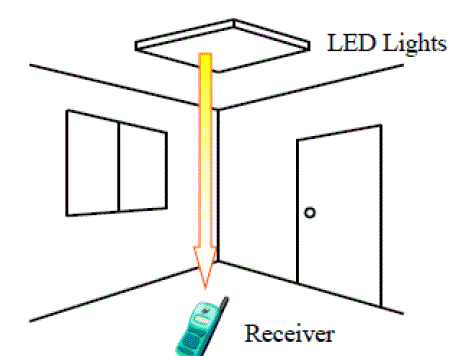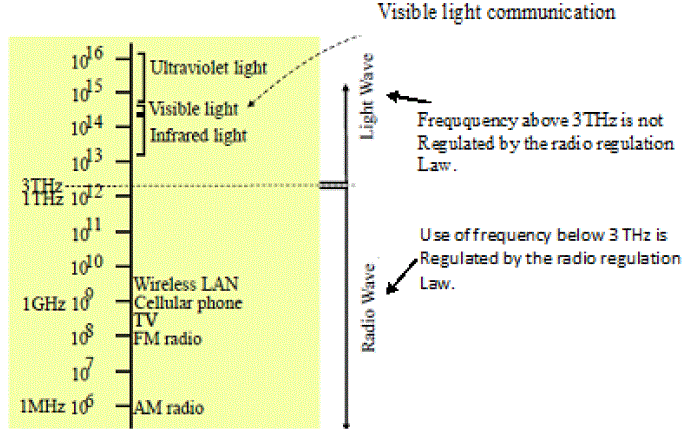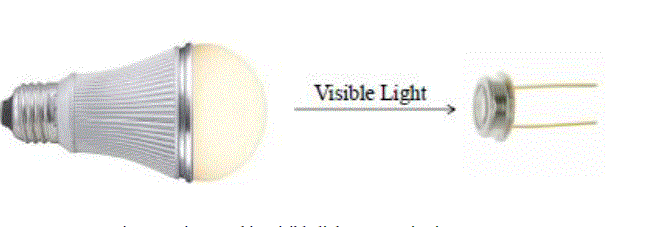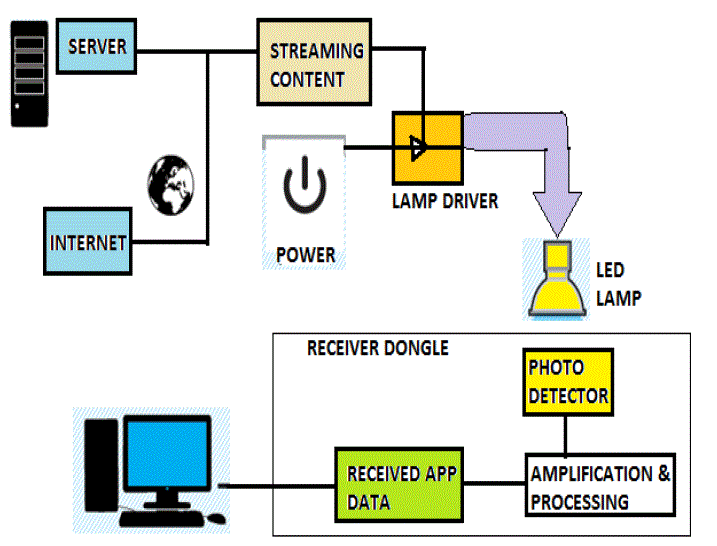Keywords
|
| VLC, Li-Fi, Wi-Fi, LED, Radio Spectrum. |
INTRODUCTION
|
| Li-Fi is a label for wireless communication system which is used to describe visible light communication technology applied to high speed wireless communication. It acquired this name due to similarity to Wi-Fi, using light instead of radio waves. This term was first used by German physicist, Harald Hass in 2011 in TED Global Talk on visible light communication [2]. In October 2011 a number of companies and industry groups formed the Li-Fi consortium, to promote high-speed optical wireless systems and to overcome the limited amount of radio based wireless spectrum available by exploiting a completely different part of the electromagnetic spectrum [5]. This technology was demonstrated in 2012 at consumer electronics show in las Vegas using a pair of Casio Smartphone’s to exchange data using light of varying intensity given off from their screens, detectable at a distance of up to 10 meters [7]. Li-Fi is transmission of data through illumination by using fiber optics and sending data through a LED that varies in intensity faster than the human eye can follow. Microchips inside LED will do the processing of data. The light intensity can be manipulated to send data by tiny changes in amplitude. The technology transfers thousands of streams of data simultaneously in higher speed with the help of special modulation technique [8]. |
| PRINCIPLE OF LI-FI TECHNOLOGY |
| Heart of Li-Fi technology is high brightness LED’s. Light emitting diodes can be switched on and off faster since operating speed of LED’s is less than 1 μs, than the human eye can detect, causing the light source to be appear continuously. This invisible on-off activity enables a kind of data transmission using binary codes. Switching on and LED is a logical ‘1’, switching it off is a logical ‘0’.It is possible to encode data in the light by varying the rate at which LED’s flicker on and off to give different strings of 1s and 0s. Modulation is so fast that human eye doesn’t notice [3].A light sensitive device (photo detector) receives the signal and converts it back into original data. This method of using rapid pulses of light to transmit information wirelessly is technically referred as Visible Light Communication (VLC) though its potential to compete with conventional Wi-Fi has inspired the popular characteristics Li-Fi [8]. |
| Visible Light Communication |
| Li-Fi is a fast and cheap version of Wi-Fi, which is based on visible light communication (VLC). The Visible light communication is a data communications medium using visible light between 400 THz (780 nm) and 800 THz (375 nm) as optical carrier for data transmission and illumination [12]. Visible light is not injurious to vision. Typical example of visible light communication is given in fig.1 below. |
| The importance of using VLC is that |
| ? Frequency above 3 THz is not regulated by radio regulating laws as shown in fig.2. |
| ? Visible light LED can be used almost everywhere. Infrared light is already used for communication such as wireless remote control, Infrared wireless LAN and Infrared inter-building communication. Visible light LED’s are beginning to be used in every home and office, which makes visible light LED’s ideal for ubiquitous data transmitter. Growth rate of LED lighting is expected to triple from 2009 to 2012 & market share of LED lighting will be more than 30 % of total lighting market in 2016. |
| ? Image sensors can be used as receivers. The use of image sensors as receiver makes it possible to detect incoming data and accurate direction of incoming vector from transmitter to receiver. The image sensor technology will allow VLC to various new applications which can’t be realized by radio wave technology like indoor navigation, augmented reality, accurate control of robots or vehicles and accurate position measurement. |
| Devices used in visible light communication |
| Fig 3 shows the example of devices used in visible light communication. |
| Devices which are used for transmission purpose in VLC are visible light LED and fluorescent lamp. LED light intensity is modulated by controlling its current. The technology uses fluorescent lamps to transmit signals at 10bit/s, or LED’s for up to 500 Mbit/s. Devices which are used for reception purpose in visible light communication are pin photodiode (high speed reception up to 1Gbps), Avalanche photo diode (very sensitive reception) and Image sensor (simultaneous image acquisition and data reception) as shown in fig 4 below. |
CONSTRUCTION AND WORKING OF LI-FI TECHNOLOGY
|
| Li-Fi is implemented using white LED light bulbs at downlink transmitter. These devices are used for illumination only by applying a constant current. By fast and subtle variations of the current, optical output can be made to vary at extremely high speeds. This variation is used to carry high speed data. Working of Li-Fi is shown in fig. 5 below. An overhead lamp fitted with an LED with signal processing technology streams data embedded in its beam at ultra high speeds to the photodiodes. A receiver dongle than converts the tiny changes in amplitude into an electrical signal, which is then converted back into a data stream & transmitted to a computer or mobile device. |
FUTURE APPLICATIONS
|
| Visible light communication advantages in hazardous or tough conditions. Li-Fi used in sensitive areas such as aircraft for data transmission without causing interference. However light waves can’t penetrate walls [3]. It is used in places where it is difficult to lay optical fibres like operation theaters and at traffic signal. In traffic signals, Li-Fi can be used to communicate with the LED lights of cars and might alert drivers when other vehicles are too close so accident numbers can be decreased. Traffic lights could better regulate traffic flow using data. It can also be used in hospitals and aeroplanes where radio signals are prohibited [11]. It will transform air travel by allowing overhead cabin light to connect mobiles and laptops in flight and it will improve conditions for those working underwater on oil rigs where radio waves can’t go through. Thousands and millions of street lamps can be transferred to Li-Fi lamps to transfer data. It can be used in petroleum and chemical plants where other transmission or frequencies could be hazardous [9]. |
COMPARISON BETWEEN LI-FI AND WI-FI
|
| Li-Fi is a terminology which is used to describe visible light communication technology applied to high speed wireless communication. Wi-Fi is great for general wireless coverage within buildings, and Li-Fi is ideal for high density wireless data coverage in confined area and for relieving radio interference issues, so the two technologies can be considered complimentary [4]. Comparisons of two technologies are given below in table 1. |
CHALLENGES FOR LI-FI
|
| Apart from many advantages over Wi-Fi, Li-Fi technology is facing some challenges. Li-Fi requires line of sight. When set up outdoors, the apparatus would need to deal with ever changing conditions. Indoors, one would not be able to shift the receiving device. A major challenge facing Li-Fi is how the receiving device will transmit back to transmitter. One more disadvantage is that visible light can’t penetrate through brick walls as radio waves and is easily blocked by somebody simply walking in front of LED source [10]. A side effect of Li-Fi is that your power cord immediately becomes your data stream, so if you have power, you have internet [6]. |
CONCLUSION
|
| In future, data for laptops, smart phones & tablets can be transmitted through light in room by using Li-Fi. Researchers are developing micron sized LED which are able to flicker on & off around 1000 times quicker than larger LED. They offers faster data transfers and take up less space so we could save space or add more LED’s to further boost the channel of communication. Also 1000 micron sized LED can fit into area required by 1sq. mm large single LED. A 1 sq.mm sized array of micron sized LED’s could therefore communicate 1000×1000 (i.e. a million) times as much information as a single 1mm LED. We can be sure that the future for Li-Fi is bright. Li-Fi consortium believes it is possible to achieve more than 10Gbps, theoretically allowing a high definition film to be downloaded in 30 seconds. [5] |
Tables at a glance
|
 |
| Table 1 |
|
| |
Figures at a glance
|
 |
 |
 |
 |
 |
| Figure 1 |
Figure 2 |
Figure 3 |
Figure 4 |
Figure 5 |
|
| |
References
|
- SchnichiroHaruyama, ‘Visible light communication, Recent activities in Japan’, Smart spaces: A smart lighting ERC industry- Academia day at BU Photonics center, Boston University, Feb 8, 2011.
- Harald Haas, ‘Wireless data from every light bulb’, TED Global, Edinburgh, July 2011.
- Ian Lim, ‘Li-Fi – Internet at the Speed of Light’, the gadgeteer, 29 August 2011.
- http://computerinformationsite.com/2011/09/07/networking-through-lights-optical-data-transfer- using- li-fi, 7 September 2011.
- Gordon Povey, ‘Li-Fi Consortium’, dated 19 October 2011.
- William Connell, http://www.servondesign.co.uk/thoughts/li-fi-internet-connection-using-light-source,Oct 26,2011
- ‘Visible-light communication: Tripping the light fantastic: A fast and cheap optical version of Wi-Fi is coming’, The Economist, dated 28 Jan 2012.
- http://heightech.blogspot.in/2012/10/lifi-latest-technology-in-wireless.html, October 2012.
- ‘Li-Fi: Data through Light’, The Institute of Engineers, Technorama Magazine, Volume 62, pp. 41, December 2012.
- http://www.ispreview.co.uk/index.php/2013/01/tiny-led-lights-set-to-deliver-wifi-style-internet-communications.html, January 2013.
- http://technoassert.com/2013/01/30/light-fidelity-li-fi-future-of-communication, 30 January 2013
- en.wikipedia.org/wiki/visible_light_communication
|